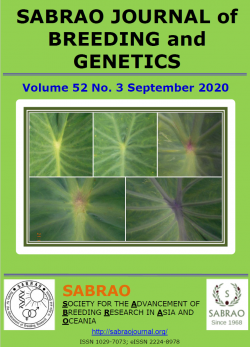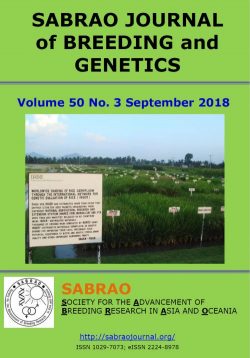Tag Archive Indonesia

SABRAO Journal Releases September 2020 Issue, Volume 52
SABRAO Journal’s third issue for 2020 features articles on rice, pandan, foxtail millet, taro, and french beans.

SABRAO JOURNAL of BREEDING and GENETICS Volume 50 Number 3 SEPTEMBER 2018
This September 2018 issue covers articles on rice, maize, soybean, mango, shallots, olive, and cereals.

SABRAO JOURNAL of BREEDING and GENETICS Volume 50 Issue 2 June 2018
This second issue of SABRAO for 2018 features articles on rice, ground nut, Gandaria; various markers such as RAPD, inter-simple sequence repeat; and different environments such as semi-arid, and drought environments.
SABRAO JOURNAL of BREEDING and GENETICS VOLUME 49 ISSUE 2 June 2017
In this issue, articles are on rice, artichoke, pomegranate, chili pepper, sorghum and sesame.
VOLUME 49 ISSUE 3; September 2017
On this volume, studies are on maize, rice, wheat, peanut, Karanda, and mangosteen.
SABRAO Journal Volume 48 Issue 4 December 2016
This last issue for 2016 contains articles on yams, Indian mustard, rice, linseed, artichoke, and eggplants.
SABRAO Journal Volume 48 Issue 2 June 2016
In this issue, articles are on wheat, cassava, maize, indian mustard, eggplant, rice, rape seed, etc.
SABRAO Journal Volume 47 Issue 4 December 2015
This final issue for 2015 contains articles on tomato, jatropha, rice, maize, linseed, pea, lentil, fenugreek, rice, etc
SELECTION AND VALIDATION OF M4 SOYBEAN MUTANT LINES THROUGH MULTICHARACTERS APPROACH
E.G. LESTARI, R. YUNITA, and M.F. ANSHORI
Mutation breeding is more effective than conventional breeding when the existing breeding material has a narrow genetic base and the scarcity of germplasm to specific desired characters. Assembling superior soybean cultivars through mutation breeding requires an effective selection method since the selection for productivity only proved less effective. Therefore, the selection base needs to be broad and use multi-characters. The latest study aimed to analyze the effectiveness of the multi-characters approach in the selection and validation process of M4 soybean mutant lines. This study evaluated M4 and M5 mutant lines for various traits at the Citayam and Muara Experimental Garden, Bogor, Indonesia. The M4 and M5 mutant evaluations used an augmented design with 121 experimental units (172 lines and four check cultivars) and a randomized complete block design with 99 experimental units (29 lines and four check cultivars), respectively. Measured variables included the number of branches, filled pods, empty pods, and productive internodes, the weight of 100 seeds, and the seed weight per sampling plot. The result showed that the correlated multi-characters were effective for selection in the soybean mutant lines. The most effective secondary character resulted from the number of filled pods. Measuring the selection effectiveness continued up to the fifth generation (M5) to further validate the selected material. In total, nine mutant lines, i.e., A182-13, A179-1, A220-156, A196-57, A186-27, A190-38, A180-6, A195-50, and A188-32, attained selection with significant genetic potential for further study through the yield test.
Keywords: Soybean (Glycine max L.), genetic diversity, multivariate analysis, mutation breeding, secondary characters
Key findings: Assembling superior soybean cultivars through mutation breeding requires an effective method of selection. The multi-traits selection method showed efficiency in selecting the promising mutant lines. Obtaining the final 10 mutant lines proceeded based on the greater genetic potential, with further study of these lines through yield testing recommended.
Download this article
Date published: December 2022
DOI: http://doi.org/10.54910/sabrao2022.54.5.10
DNA BARCODING OF CANANGA ODORATA (LAM. HOOK.F. & THOMSON) USING CHLOROPLAST GENES IN NORTH SUMATRA, INDONESIA
E. PRASETYA, LAZUARDI, A. HASAIRIN, Y. RACHMAWATI, M. JANNAH, and T. HARSONO
SUMMARY
Cananga odorata (Lam.) Hook.f. & Thomson, a member of the Annonaceae family, has become widespread from the Indo-Malayan region to northern Australia and Malaysia. This plant has economic value because it produces essential oils used in the perfume and food industries. No research existed yet related to DNA barcoding to see intraspecific variations in C. odorata. This study aimed to analyze the potential of chloroplast genes maturase K (matK)-trnK, ribulose 1,5-biphosphate carboxylase (rbcL), and trnL-F intergenic spacer as DNA barcodes on C. odorata from North Sumatra, Indonesia. The research sample obtained from five areas included Tanjung Balai, Langkat Regency (Tangkahan Conservation Forest), Medan, Tanjung Morawa (Deli Serdang Regency), and Sukarasa (Deli Serdang Regency). Phylogenetic analysis using the three markers showed that C. odorata was monophyletic grouped from a common ancestor. The results of the phylogenetic tree construction also showed that the three markers used were able to group each genus in the Annonaceae family and form separate branches from the outgroup (Magnolia, Sarcandra, and Litsea). The barcoding gap on the genetic distance could not be observed in this study, although phylogenetic results showed that the three markers were discriminatory enough to separate species. The results showed that the matK-trnK, rbcL, and trnL-F markers could be effectively used as DNA barcodes to identify C. odorata.
Keywords: Cananga odorata, DNA barcoding, chloroplast genes, North Sumatra
Key findings: There are no barcoding gaps in the matK-trnK, rbcL, and trnL-F markers, although phylogenetic results show that three barcode markers are quite discriminatory to separate the Annonaceae species. DNA barcode matK-trnK, rbcL, and trnL-F revealed as efficient tools to identify C. odorata.
Download this article
Date published: December 2022
DOI: http://doi.org/10.54910/sabrao2022.54.5.9